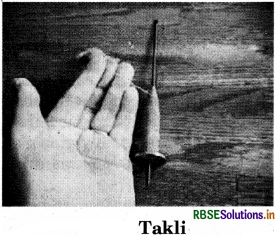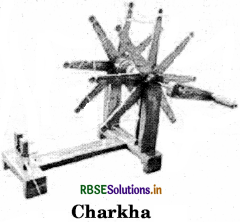RBSE Solutions for Class 6 Science Chapter 3 Fibre to Fabric
Rajasthan Board RBSE Solutions for Class 6 Science Chapter 3 Fibre to Fabric Textbook Exercise Questions and Answers.
Rajasthan Board RBSE Solutions for Class 6 Science in Hindi Medium & English Medium are part of RBSE Solutions for Class 6. Students can also read RBSE Class 6 Science Important Questions for exam preparation. Students can also go through RBSE Class 6 Science Notes to understand and remember the concepts easily. Browsing through class 6 science chapter 4 extra questions that includes all questions presented in the textbook.
RBSE Class 6 Science Solutions Chapter 3 Fibre to Fabric
RBSE Class 6 Science Fibre to Fabric InText Questions and Answers
Page 19
Question 1.
Boojho has seen in the museum, items like the one shown here. These were worn by warriors. He wants to know which kind of fibres are used to make clothes by warriors?
Answer:
The warriors used to wear armours that were not made up of fabric. The armours are made of small pieces of metal joined by thin metal wires.

Page22
Question 2.
Paheli wants to know if you have seen any fabrics that are made of the fibres on the outer covering of the coconut. What are these fibres normally used for?
Answer:
Coir is the fibre on the outer covering of coconut. It is a natural fibre extracted from the husk of coconut. It is used to make floor mats, door mats, brushes, and mattresses.
Page 25
Question 3.
Boojho knows that burning of cotton yarn gives an odour similar to burning paper. He is wondering if he can assume that paper is also made from plants.
Answer:
Paper is made from wood pulp which is obtained from trees.
RBSE Class 6 Science Fibre to Fabric Textbook Questions and Answers
Question 1.
Classify the following fibres as natural or synthetic:
nylon, wool, cotton, silk, polyester, jute.
Answer:
Natural fibres: Wool, cotton, silk, jute.
Synthetic fibres: Nylon, polyester.
Question 2.
State whether the following statements are True or False:
(a) Yarn is made from fibres.
(b) Spinning is a process of making fibres.
(c) Jute is the outer covering of coconut.
(d) The process of removing seed from cotton is called ginning.
(e) Weaving of yarn makes a piece of fabric.
(f) Silk fibre is made from the stem of a plant.
(g) Polyester is a natural fibre.
Answer:
(a) True
(b) False
(c) False
(d) True
(e) True
(f) False
(g) False.
Question 3.
Fill in the blanks:
(a) Plant fibres are obtained from ............................... and ...............................
(b) Animals fibres are ............................... and ...............................
Answer:
(a) fruits, stems
(b) silk, wool.
Question 4.
From which parts of the plant cotton and jute are obtained?
Answer:
Cotton is obtained from the fruits of the cotton plant, called cotton bolls. Jute is obtained from the stem of the jute plant.

Question 5.
Name two items that are made from coconut fibre.
Answer:
(a) Doormats
(b) Ropes.
Question 6.
Explain the process of making yarn from fibre.
Answer:
The process of making yam from fibres is called spinning. In this process, fibres from a mass of cotton are drawn out and twisted. This brings the fibres together to form a yarn. Spinning is done at home using simple devices like hand spindle (takli) and charkha. On large scale, big spinning machines are used.



- RBSE Solutions for Class 6 Science Chapter 1 भोजन: यह कहाँ से आता है?
- RBSE Solutions for Class 6 Science Chapter 12 Electricity and Circuits
- RBSE Class 6 Science Notes in Hindi & English Medium Pdf Download
- RBSE Class 6 Science Important Questions in Hindi Medium & English Medium
- RBSE Solutions for Class 6 Science in Hindi Medium & English Medium
- RBSE Class 6 Science Important Questions Chapter 16 Garbage In, Garbage
- RBSE Class 6 Science Important Questions Chapter 15 Air Around Us
- RBSE Class 6 Science Important Questions Chapter 14 Water
- RBSE Class 6 Science Important Questions Chapter 13 Fun with Magnets
- RBSE Class 6 Science Important Questions Chapter 12 Electricity and Circuits
- RBSE Class 6 Science Important Questions Chapter 11 Light, Shadows and Reflections